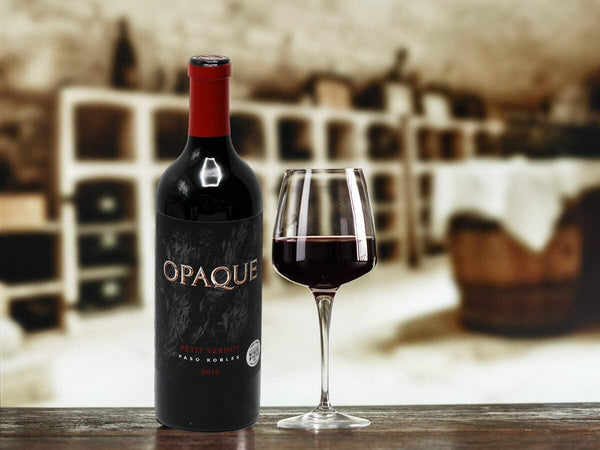The Charms of Petit Verdot: A Tantalizing Exploration

Each grape varietal boasts its unique allure for both vignerons and wine drinkers. Petit Verdot stands out as the winemaker’s enigmatic gem. Often playing a behind-the-scenes role in Bordeaux blends, this grape possesses an intriguing personality worth discovering. Read on to unveil the essence of Petit Verdot, including an outstanding example: the 2018 Opaque from the Central Coast of California. We will also explore its contributions to other blended wines worldwide that follow the Bordeaux style.
The Mystique of Petit Verdot
Originating from the Bordeaux region in France, Petit Verdot's name is a nod to its late ripening tendencies and its small, densely packed berries. Its most distinctive characteristic is its inky, deep-purple color, which imparts richness and intensity to the wines it graces. Aromatically, it teases the senses with a bouquet of dark fruits, where black plum and currant often take center stage. On the palate, it unfolds a journey of flavors, characterized by structured tannins that provide texture and depth, culminating in a lingering, full-bodied finish.
Let's shine the spotlight on the 2018 Opaque Petit Verdot, which you can easily get through online wine delivery: it’s a stellar example of what this grape can achieve, especially by adding oak maturation. After aging for 24 months in a harmonious blend of French and American oak barrels, this wine showcases a symphony of flavors, earning it 91 points from Wine Spectator. Ripe black plums and currants steal the show, with subtle notes of vanilla and dark chocolate adding depth and complexity. Its structured tannins provide an alluring texture and depth, and the finish is notably lengthy, inviting enthusiasts to savor every moment.
The 2018 Opaque Petit Verdot embodies the intrinsic allure of this grape variety, inviting you to relish its profound and enigmatic qualities. It stands as a testament to the potential of Petit Verdot as a solo act, deserving recognition for its captivating character. As climate change affects vineyard conditions, we may actually see more and more wines dominated by this varietal.
Petit Verdot's Role in Bordeaux Blends
While Petit Verdot can shine on its own, it truly excels when woven into the fabric of red wine blends. Bordeaux, a region celebrated for its red wines, often incorporates Petit Verdot as an essential element in the ensemble. These blends typically feature a harmonious marriage of Cabernet Sauvignon, Merlot, Cabernet Franc, Malbec, and, yes, Petit Verdot. The result is a symphony of flavors, with Petit Verdot contributing its intense color, robust tannins, and captivating dark fruit notes that enrich the overall profile and ensure a lasting, elegant finish. When you order wine online, some Bordeaux blends that typically feature Petit Verdot include:
Château Pétrus: A renowned Pomerol estate that sometimes incorporates Petit Verdot, contributing to the elegance and depth of its wines.
Château Margaux: Another Bordeaux icon, Château Margaux, embraces Petit Verdot to infuse complexity and longevity into their wines.
Château Haut-Brion: This prestigious estate in Pessac-Léognan often uses Petit Verdot in its blends, enhancing the character and structure of their wines.
Château Leoville Las Cases: Located in Saint-Julien, this estate features Petit Verdot in its Bordeaux blends, imparting depth and vibrancy to their wines.
Château Palmer: Petit Verdot plays a role in the blends of Château Palmer, adding an extra layer of complexity and uniqueness to their wines.
Apart from these wines, Petit Verdot finds its place in several other esteemed reds, further exemplifying its versatility and charm. Some of these blends include Opus One, inspired by Bordeaux traditions. Opus One from Napa Valley typically includes Petit Verdot in its blends, resulting in wines of remarkable depth and character. Sassicaia, an acclaimed Super Tuscan from Italy, also often incorporates Petit Verdot, contributing to the structure and complexity of its wines. Another example is Mas de Daumas Gassac, from Languedoc.
In terms of food pairing, think of Petit Verdot as similar to other hearty red wine bottles. It compliments red meats, barbecue, and rich stews.
Petit Verdot, with its deep history and its remarkable role in the world of winemaking, adds an intriguing dimension to the world of wine. Whether enjoyed in a varietal form, such as the 2018 Opaque Petit Verdot, or as a vital component in Bordeaux blends and other esteemed wines, it promises an exploration of flavors and aromas that will captivate wine enthusiasts. So, the next time you seek a wine that encapsulates enigmatic elegance, consider Petit Verdot, and embark on a journey of taste and discovery that will delight your senses and leave a lasting impression.


















Leave a comment